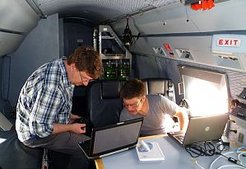Worldwide atmospheric measurements with research aircraft HALO
For now five years the unique research aircraft HALO (High Altitude and Long Range Research Aircraft) is set to target greenhouse gases in the atmosphere. Halo operations range from the entry in the stratosphere, overflying the North and South poles up to collecting climate data in the most remote areas of the globe. During the HALO symposium on March 14, 2017 at the German Aerospace Center DLR the manifold and cross-linked HALO research projects will be presented. Ministerial officials will catch up on the results of the past 18 missions as well as on the planned missions up to the year 2022.

Christoph Gerbig, group leader at the Max Planck Institute for Biogeochemistry, participates in HALO with the development of innovative and high-precision instrumentation for airborne measurements of the two most significant greenhouse gases, methane and carbon dioxide. The new technology has to fulfill special requiremements according to the particular conditions on board relating to vibration, weight, and safety. This spring the CoMet flight campaign (Carbon dioxide and methane mission for HALO) will observe the distribution of atmospheric trace gases over Europe. The collected data will be interpreted with high-resolution transport modelling to better understand the gas exchange between the atmosphere and the land surface.
The research aircraft HALO is supported by a joint initiative of several German environmental and climate research institutions. It has been realized by the German Federal Ministeries, the Helmholtz Association, and the Max Planck Society. Maintenance is assured by the support of the German research association DFG, the Max Planck Society, the Karlsruhe Institute of Technology, German Research Centre for Geosciences, and the the Leibniz Institute for Tropospheric Research. DLR owns and manages the plane.












